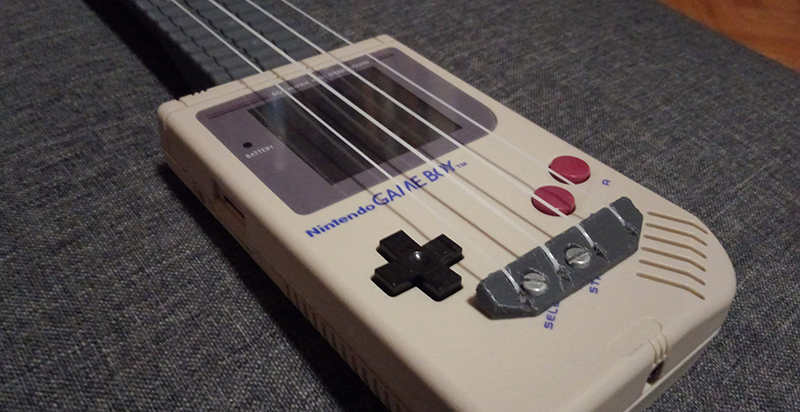When you think about singer-songwriters, the name Bob Dylan might come to your mind. You might think about Jeff Buckley, you might think about Hank Williams, Springsteen, David Bowie, or Prince. You’d be wrong. The greatest singer-songwriter of all time is Tiny Tim, the guy who looks like Weird Al traveled in time and did a cameo in Baker-era Doctor Who. Tiny Tim had the voice of an angel, because Mammon and Belial were angels too, I guess. Tiny Tim is also the inspiration behind the current resurgence of the ukulele, the one thing keeping the stringed instrument industry alive today.
Even though Tiny Tim passed in 1996, he would have loved to see this project that brings the ukulele into the late 20th century. It’s a Game Boy, DMG-01, transformed into a playable musical instrument. It’s a functional uke, but it also has electronics to turn this into a chiptune machine.
The first goal of this project was to build a functional ukulele out of a Game Boy case. This was simple enough — the neck was 3D printed, the bridge was screwed in, and the case of the Game Boy was reinforced with some PCB material. So far, this is nothing new; you can get a model for a 3D printed ukulele on Thingiverse.
The second goal of this project was to make this ukulele into a chiptune machine. This means designing a pickup for the strings, and since these are nylon you’re not going to do a magnetic pickup on a ukulele. The first solution was an IR reflectance sensor, which worked but had too high of a power draw. The better solution was a standard flex pressure sensor, which worked well enough. This signal is distorted into a square wave that gives a surprisingly Game Boy-like sound. You can check out the video demo below.
















Brian, have you no shame?
Throwing in the offhand remark about Tiny Tim being responsible for the popularity of the Ukulele is nothing short of yellow journalism. You should be ashamed of yourself.
Obviously your being a big fan of Tiny Tim has shaded your objectivity and put your musical taste in question. While his musical scholarship no doubt had merit his vocal renditions had all the tonal quality of an alley cat with it’s balls stuck in the gate just as it was jumping down after a full night of caterwauling.
Come on Brian!
Jake Shimabukuro seems to be contributing his fair share to the ukulele scene:
https://www.youtube.com/watch?v=FBemZJFEst4
That Game boy uke need some tuning!
For some interesting sounds from a uke
https://m.youtube.com/results?search_query=ukulele+billy+jean
That Game boy uke needs some friends like in…
https://www.youtube.com/watch?v=dKpzCCuHDVY
I was going to post about it being a shame to disfigure an ever rarer source of nintendium but then I noticed the screws are above the start and select labels. Does that mean the case is unmodified? If so, kudos for your engineering ingenuity.
Also, nice touch for the cartridge shape at the head.
thanks, yes the screw pass throught the start and select button hole. holle the projet need no hole or glue.
best regards,
Alex
Am I the only one who hopes it plays the gameboy chime when it’s powered on?
any reason for not using metal strings and a magnetic pickup?
Metal strings would need to be ferrous. Ferrous strings for ules and guitars are used on acoustic and electric models and are under much higher tension than classical strings. These instruments are specially reinforced to suit. Putting them on in instrument not designed for the high tension will bend/break the neck. “Wire wound” nylon strings do not use ferrous material and would not excite a magnetic pickup. Maybe you could run a current through a wire woound nylon string to get a magnetic field…
it’s really hard to get single string magnetic pickup not polluted by other string.
Metal string get lot more tension and too hard for the 3D printed part.
The metal string will “eat” the plastic fingerboard, with nylon string the fretboard can last at leat 5years of intensive use.
The IR reflective pickup are cheap (around 2$) and easy to find. magnetic pickup need to be custom made, and here i want to make an easy to make Ukulele, not a full diy project.
best regads,
Alex
Metal string will “eat” plastic fret-board too quickly. with nylon string it’s easiest to find for ukulele (fish string if you want)
Magnetic pickup are extremely difficult to not get polluted by other string (for electric guitar we don’t care) and must be custom made
IR reflective pickup are easy to find and cheap (around 2$) and can be full onted on pcb in manufacturing.
best regards,
Alex
Ah, thanks for the clarification, I wasn‘t aware of that
Sweet!
No offense but this is not chiptune. Chiptune music comes from using actual video game hardware to create music. Just because you get aomething like a square wave out of this doesn’t make it chiptune. It just sounds like a bad electric guitar put through a battery powered amp with dying batteries. The Ukulele is cool and impressive. Let’s just not overstate what the end result is.
I know the sound is great for now and the definition of chiptune but the project is only at is beginning.
Now I have a DSP to correctly emulate chiptune sound.
the trashy sound come from logic gate use as amplifier which work great at the start of the sound but dont square up the signal for the end of the sound